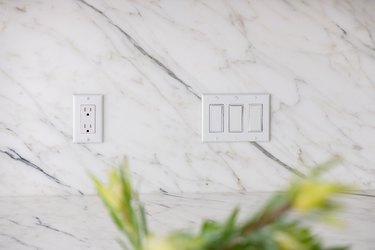Do you need to plug in an electric kettle, a floor lamp, or a refrigerator? In all of these cases and many more, you'll need a 120-volt power outlet, more correctly called a 120-volt receptacle. Every house in North America has them unless the house happens to be off-grid and powered by solar panels, and even most of these houses have 120-volt receptacles. They're everywhere, but they don't all look the same.
The first electrical receptacles had screw-in socket bases, but in the 1910s, Harvey Hubbell invented the two-pin plug and receptacle pair, and the standard design has been only slightly modified since then. Grounded 120-volt receptacles have three slots, and polarized receptacles have slots of different sizes, which ensure that electricity can only flow in one direction. These features are incorporated into most modern receptacles.
Video of the Day
Video of the Day
GFCI receptacles have internal circuit breakers and test and reset buttons mounted on the faceplate. You might find receptacles with two slots of the same size in some older homes, but they are obsolete in North America. They are more common in Japan, where the standard voltage is 100 volts, not 120 volts as it is in North America.
Why Is 120 Volts the Standard Voltage?
Electricity is supplied to residential electric panels at a voltage of 240 volts. This standard owes its origin to Thomas Edison, and today, it's observed around the world. In many countries in Europe and elsewhere, 240-volt electricity is fed throughout the building, but in North America, the voltage is split at the panel into two 120-volt legs. This allows the option of powering lights and appliances at a lower, safer voltage while still powering appliances that use a lot of electricity.
You may see small appliances rated for 110, 115, or 125 volts and larger ones rated for 220, 230, or 250 volts. These are all basically equivalent to 120 and 240 volts, respectively. The differences are due to voltage fluctuations caused by transmission losses and various other factors that affect alternating current signals. Every 120-volt receptacle has a current rating, the two most common being 15 and 20 amps. Code requires higher amperage ratings in situations where higher power draw is expected.
Wiring for 120-Volt Receptacles
Voltage is split at the electric panel by adding a return path to the line transformer. You create a 120-volt circuit by connecting a wire to one of the 120-volt legs (via a circuit breaker) and another to the return bus (the return wire is also called the neutral wire). The line wire, which carries voltage, is usually black (although it can be red), and the neutral wire is always white.
A 120-volt outlet usually has four terminals — two are brass, and two are chrome — and a ground terminal. The black line wire connects to one of the brass terminals, and the white return wire connects to the corresponding chrome one. To daisy-chain to another receptacle (known as a load), you connect a black and white wire to the remaining terminal pair, pull those wires to the load receptacle, and hook them up to a brass/chrome terminal pair on that receptacle.
Receptacles must be connected to a ground bar on the panel for safety. The ground wire is usually bare (sometimes green), and it connects to the green ground terminal on the receptacle. When there is more than one cable in the electrical box, all the ground wires are bonded together and connected to the receptacle's ground terminal.
GFCIs and 240-Volt Outlets
All 120-volt receptacles, whether they are polarized or have ground pins, are wired in the same way, with one exception. A GFCI receptacle has an internal breaker that works only if electricity follows a certain path through the receptacle. The line wires that supply electricity must be connected to the line terminals on the receptacle, which are clearly marked, or ground-fault protection is lost.
Receptacles for 240-volt appliances don't look like 120-volt receptacles, and they aren't wired the same way. They are larger, they usually have four slots (although some older ones have only three), and the slots can be arranged in a variety of configurations depending on amperage. Receptacles for 240-volt circuits have terminals for two hot wires (usually red and black), a neutral wire, and usually a ground wire, and you never daisy-chain them. Because 240-volt circuits are designed to supply more power, the wires are heftier (8- or 10-gauge as opposed to 12- or 14-gauge), so the terminal lugs are bigger.
